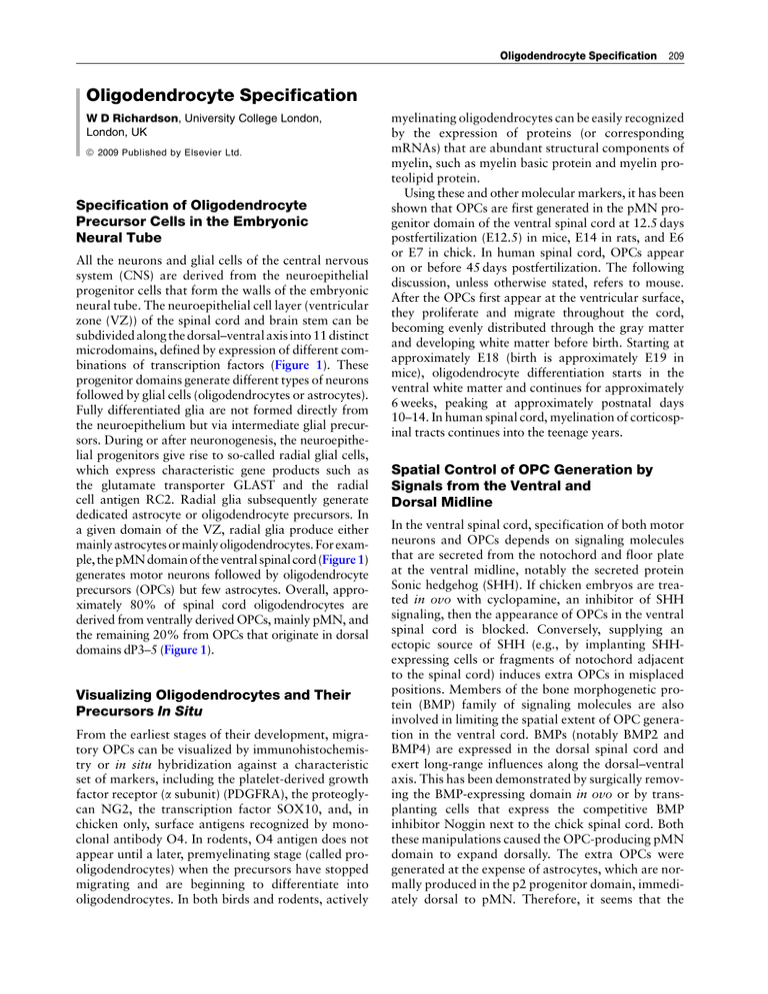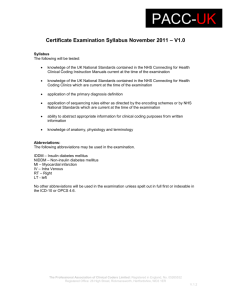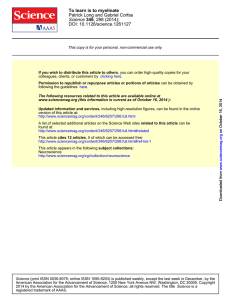Oligodendrocyte Specification
advertisement

Oligodendrocyte Specification 209 Oligodendrocyte Specification W D Richardson, University College London, London, UK ã 2009 Published by Elsevier Ltd. Specification of Oligodendrocyte Precursor Cells in the Embryonic Neural Tube All the neurons and glial cells of the central nervous system (CNS) are derived from the neuroepithelial progenitor cells that form the walls of the embryonic neural tube. The neuroepithelial cell layer (ventricular zone (VZ)) of the spinal cord and brain stem can be subdivided along the dorsal–ventral axis into 11 distinct microdomains, defined by expression of different combinations of transcription factors (Figure 1). These progenitor domains generate different types of neurons followed by glial cells (oligodendrocytes or astrocytes). Fully differentiated glia are not formed directly from the neuroepithelium but via intermediate glial precursors. During or after neuronogenesis, the neuroepithelial progenitors give rise to so-called radial glial cells, which express characteristic gene products such as the glutamate transporter GLAST and the radial cell antigen RC2. Radial glia subsequently generate dedicated astrocyte or oligodendrocyte precursors. In a given domain of the VZ, radial glia produce either mainly astrocytes or mainly oligodendrocytes. For example, the pMN domain of the ventral spinal cord (Figure 1) generates motor neurons followed by oligodendrocyte precursors (OPCs) but few astrocytes. Overall, approximately 80% of spinal cord oligodendrocytes are derived from ventrally derived OPCs, mainly pMN, and the remaining 20% from OPCs that originate in dorsal domains dP3–5 (Figure 1). Visualizing Oligodendrocytes and Their Precursors In Situ From the earliest stages of their development, migratory OPCs can be visualized by immunohistochemistry or in situ hybridization against a characteristic set of markers, including the platelet-derived growth factor receptor (a subunit) (PDGFRA), the proteoglycan NG2, the transcription factor SOX10, and, in chicken only, surface antigens recognized by monoclonal antibody O4. In rodents, O4 antigen does not appear until a later, premyelinating stage (called prooligodendrocytes) when the precursors have stopped migrating and are beginning to differentiate into oligodendrocytes. In both birds and rodents, actively myelinating oligodendrocytes can be easily recognized by the expression of proteins (or corresponding mRNAs) that are abundant structural components of myelin, such as myelin basic protein and myelin proteolipid protein. Using these and other molecular markers, it has been shown that OPCs are first generated in the pMN progenitor domain of the ventral spinal cord at 12.5 days postfertilization (E12.5) in mice, E14 in rats, and E6 or E7 in chick. In human spinal cord, OPCs appear on or before 45 days postfertilization. The following discussion, unless otherwise stated, refers to mouse. After the OPCs first appear at the ventricular surface, they proliferate and migrate throughout the cord, becoming evenly distributed through the gray matter and developing white matter before birth. Starting at approximately E18 (birth is approximately E19 in mice), oligodendrocyte differentiation starts in the ventral white matter and continues for approximately 6 weeks, peaking at approximately postnatal days 10–14. In human spinal cord, myelination of corticospinal tracts continues into the teenage years. Spatial Control of OPC Generation by Signals from the Ventral and Dorsal Midline In the ventral spinal cord, specification of both motor neurons and OPCs depends on signaling molecules that are secreted from the notochord and floor plate at the ventral midline, notably the secreted protein Sonic hedgehog (SHH). If chicken embryos are treated in ovo with cyclopamine, an inhibitor of SHH signaling, then the appearance of OPCs in the ventral spinal cord is blocked. Conversely, supplying an ectopic source of SHH (e.g., by implanting SHHexpressing cells or fragments of notochord adjacent to the spinal cord) induces extra OPCs in misplaced positions. Members of the bone morphogenetic protein (BMP) family of signaling molecules are also involved in limiting the spatial extent of OPC generation in the ventral cord. BMPs (notably BMP2 and BMP4) are expressed in the dorsal spinal cord and exert long-range influences along the dorsal–ventral axis. This has been demonstrated by surgically removing the BMP-expressing domain in ovo or by transplanting cells that express the competitive BMP inhibitor Noggin next to the chick spinal cord. Both these manipulations caused the OPC-producing pMN domain to expand dorsally. The extra OPCs were generated at the expense of astrocytes, which are normally produced in the p2 progenitor domain, immediately dorsal to pMN. Therefore, it seems that the 210 Oligodendrocyte Specification Spinal cord progenitor domains, transcription factors and cell fates RP msx3 pax7 dbx1 nkx6.2 dP1 dP2 dP3 dP4 dP5 dP6 OPC Generation in the Forebrain INs, astrocytes, OPCs p0 INs, astrocytes p1 nkx6.1 olig2 nkx2.2 ventrally and dorsally derived OPCs in the forebrain can substitute for one another, implying that they are functionally equivalent. p2 pMN MNs, OPCs p3 FP Figure 1 Diagram of progenitor domains in the VZ of the embryonic (E11) mouse spinal cord. Domains are known as p3, pMN, etc. in the ventral half of the cord and dP6, dP5, etc. in the dorsal half. To the left of the diagram are shown the expression limits of transcription factors, some of which are mentioned in the text. Dotted lines with small arrows indicate that the expression domain expands or shrinks after it is first established. On the right are shown the cell fates of progenitors in the indicated domains (the origins of astrocytes are still tentative). FP, floor plate; INs, interneurons; MNs, motor neurons; OPCs, oligodendrocyte precursor cells; RP, roof plate. spatial extent of OPC and astrocyte production in the ventral cord is limited by mutually antagonistic actions of SHH and BMPs. The majority (approximately 80%) of OPCs in the spinal cord are generated in the ventral VZ. The remainder are generated in other progenitor domains, including dorsal domains dP3–5. The dorsally derived OPCs appear later in development than the pMNderived OPCs (approximately E15 vs. E12.5) and they migrate less widely than their ventrally derived counterparts. It seems unlikely that these dorsal progenitor domains are under the influence of SHH from the floor plate, suggesting that there might be a SHHindependent route to OPC specification. Indeed, OPCs can arise in cultures derived from SHH null spinal cord or in the presence of cyclopamine, if fibroblast growth factor-2 (FGF-2) is also present in the culture medium. OPC generation in the dorsal spinal cord might therefore depend on FGF signaling, possibly combined with a decline in BMP expression in the dorsal cord during late embryogenesis. There might even be a biochemical overlap between SHH and FGF signaling because it has been shown that both pathways depend on MAP kinase activity. It is not known whether or not ventrally and dorsally derived OPCs in the spinal cord are functionally specialized. However, there is evidence that The adult forebrain, including the cerebral cortex, develops from an embryonic structure called the telencephalon. Like the spinal cord, this starts as a simple neuroepithelial tube, although it becomes progressively more convoluted during development. There is no notochord underlying the telencephalon and no floor plate; however, the ventral neuroepithelial cells express SHH and its receptors, Patched (PTC) and Smoothened (SMO). At approximately E13.5, some cells in the ventral neuroepithelium (medial ganglionic eminence (MGE)) start to express OPC markers such as PDGFRA and SOX10 and migrate away from their origin through the ventral telencephalon. Generation of these early OPCs depends on SHH because they do not appear in embryos that lack SHH expression in the ventral telencephalon (Nkx2.1 null mice). Later, other parts of the VZ generate OPCs in a temporal wave of production from ventral to dorsal. OPCs from the MGE and lateral ganglionic eminence (LGE) initially populate the developing forebrain including the cerebral cortex before birth, to be joined after birth by OPCs that originate within the cortex. The latter OPCs remain in the cortex and do not migrate ventrally. The question of whether all these OPCs and the oligodendrocytes that they give rise to are functionally specialized, or equivalent, was addressed by killing specific subpopulations of OPCs at source. This was achieved by targeting diphtheria toxin A-chain expression to subpopulations of OPCs that originate in different domains of the telencephalic neuroepithelium (MGE, LGE, and cortex) by combinatorial use of an oligodendrocyte lineage-specific gene promoter (Sox10) and one of several promoters that are active in different parts of the VZ (Nkx2.1, Gsh2, or Emx1). These experiments showed that when OPCs originating within the cortical VZ (normally approximately 50% of all OPCs in the cortex) were ablated, the remaining ventrally derived populations expanded to make up the loss and the animals survived and lived a normal life span. Even when all telencephalic OPCs from MGE, LGE, and cortex were ablated simultaneously, they were replaced by OPCs that migrated forward from the diencephalon. A normal OPC cell density was restored – with a significant but ultimately harmless delay – indicating that OPCs from different parts of the embryonic neuroepithelium are not intrinsically different from one another despite the very different signaling environments in which they arise. Oligodendrocyte Specification 211 Of course, there might be subtle differences that would not be detected without detailed behavioral analysis of the ablated mice, but this remains to be investigated. Role of Transcription Factors in OPC Development: The OLIG Genes A major step forward in understanding the molecular control of oligodendrocyte lineage development resulted from the discovery of transcription factors that orchestrate OPC specification and differentiation. Prime among these are the oligodendrocyte lineage (OLIG) transcription factors, OLIG1 and OLIG2. These are members of the large family of basic helix–loop–helix factors that also includes the pro-neural proteins NGN1/2 and MASH1 and the cell lineage regulators MYOD and NEUROD. In the developing spinal cord, SHH induces expression of OLIG2 in pMN, prior to and during motor neuron (MN) production. OLIG2 is downregulated rapidly in postmitotic MNs but remains on in OPCs as they proliferate and migrate away through the parenchyma. OLIG2 is required for both MN and OPC specification because both cell types are lost in Olig2 null spinal cords. Pockets of OPCs persist in the brains of Olig2 null mice, but no OPCs are found anywhere in the CNS of Olig1/2 compound nulls. Therefore, OLIG1 might partly compensate for loss of OLIG2 in the brain. There is no effect on OPC generation in either the brain or the spinal cord of Olig1 null mice, although there can be severe myelination defects later. OLIG1 therefore seems to be mainly involved in the later stages of oligodendrocyte differentiation and myelination. Note that different laboratories have reported different experiences with Olig1 knockout mice, depending on whether or not the PGK-Neo cassette used to inactivate the locus was removed prior to establishing mouse lines. When the PGK-Neo cassette was left in place, there was no obvious dysmyelinating phenotype during development, possibly because of cis-acting effects of the PGK-Neo transcription unit on the nearby Olig2 gene. However, even in the latter mice there was a striking effect on remyelination of adult mice that were subjected to gliotoxin-induced experimental demyelination; such demyelinated lesions are rapidly repaired in wild-type mice but remyelination was blocked in the Olig1 knockouts. The underlying mechanism by which OLIG2 governs the sequential production of MNs and OPCs (‘neuron–glial switch’) is not known. Presumably, OLIG2 switches binding partners (transcriptional cofactors) during the transition from MN to OPC production. During the period of MN production, OLIG2 and the homeodomain transcription factor NKX2.2 are mutually repressive so that the OLIG2 and NKX2.2 expression domains (pMN and p3, respectively) are sharply demarcated (Figure 2). Later, after MN production has ceased, the cross-repression seems to relax because NKX2.2 expression creeps dorsally into pMN and an overlap region develops. Initially, it was thought that OPCs might be generated specifically within this overlap region under the cooperative activities of OLIG2 and NKX2.2. In chick, it does appear that PDGFRAþ OPCs are formed exclusively within the overlap region, but in mice OPCs arise in all parts of the OLIG2-expressing pMN domain, not just the region of overlap with NKX2.2 (Figure 2). Moreover, OPC specification is not affected in Nkx2.2 null mice, Figure 2 (a) Immunolabeling of ventral progenitor domains p3 and pMN in the mouse spinal cord with antibodies against transcription factors NKX2.2 and OLIG2, respectively. Motor neurons are still being generated at E11. (b) Three-color immunolabeling of NKX2.2 (p3, green), OLIG2 (pMN, blue), and PDGFRA (newly forming OPCs, red) in the mouse ventral spinal cord at E13. The first OPCs are formed mainly within the OLIG2-expressing pMN domain in mouse, outside the NKX2.2-expressing p3 domain. After they are formed at the ventricular surface, the OPCs migrate away rapidly in all directions to populate the spinal cord. 212 Oligodendrocyte Specification although the later stages of oligodendrocyte differentiation and myelination are delayed. A similar delay in myelination is observed in mice that lack the high mobility group transcription factor SOX10, which is known to interact with OLIG1 and OLIG2. OLIG2 has also been shown to interact physically with NKX2.2. Therefore, a picture is emerging in which OLIG1/2, NKX2.2, and SOX10 cooperate in controlling myelin gene expression and axon ensheathment. OLIG2 and other members of the SOX family (including SOX8 and SOX9) are required earlier for OPC and/or MN specification, but so far there is no compelling explanation for the neuron–glial switch. Notch–Delta signaling is clearly involved in the MN/OPC fate choice as in many other binary decisions during development. It has been shown that, in zebra fish, abrogation of Notch signaling results in excess production of MNs at the expense of OPCs. Conversely, constitutive activation of Notch signaling results in excess OPCs at the expense of MNs. A wellestablished general function of Notch–Delta signaling is to maintain precursor cells in an immature state and to inhibit premature cell cycle exit and differentiation, thus preserving part of the precursor pool for generation of later-born cell types. Since MNs are formed before OPCs, the gain- and loss-of-function experiments in zebra fish spinal cord can be interpreted in those terms – implying that Notch signaling might play a permissive rather than an instructive role in the MN/OPC fate choice. Control of OPC Proliferation After they are specified in the embryonic VZ, OPCs proliferate and migrate away from their sites of origin, distributing widely and uniformly throughout the CNS before associating with axons and differentiating into myelin-forming oligodendrocytes (Figure 3). Several mitogenic polypeptides have been shown to influence OPC proliferation in culture and/or in vivo, including PDGF, FGF, and cytokines. These probably act in concert with one another, possibly in different combinations in different regions of the CNS and/or at different stages of OPC development. OPCs express receptors for PDGF (PDGFRA subtype), and many neurons and astrocytes synthesize PDGF-A. PDGF-A null mice have reduced OPC numbers (approximately 10% normal numbers in the spinal cord and approximately 50% in the cerebral cortex) and correspondingly reduced amounts of myelin. Therefore, homodimeric PDGF-AA is an essential mitogen for OPCs in vivo. PDGF-AA is also strongly mitogenic for OPCs in mixed neural cell cultures, such as mixed glial cell cultures derived from perinatal rat optic nerve. However, PDGF-AA is not very mitogenic for pure, immunoselected populations of OPCs cultured on their own in the absence of other cell types. There are other essential mitogens or mitogenic cofactors released into the extracellular medium of mixed cell cultures that are required to cooperate with PDGF-AA. One of these is the CXC cytokine GRO-alpha. Astrocytes are a major source of GROalpha in optic nerve cultures and probably also in vivo. Cell adhesion molecules, notably integrin family members, also synergize with PDGF and possibly other polypeptide mitogens to drive OPC proliferation at limiting mitogen concentrations. FGF-2 also enhances the mitogenic effect of PDGFAA for OPC glial cell cultures. OPCs cultured with both PDGF-AA and FGF-2 can proliferate seemingly indefinitely without differentiating, whereas PDGFAA in the absence of FGF allows limited OPC proliferation followed by oligodendrocyte differentation. FGF-2 on its own in the absence of PDGF is mitogenic for a late stage of OPC development, when OPCs stop migrating and express the O4 antigen prior to Figure 3 OPCs, visualized by in situ hybridization for Pdgfra mRNA, in the developing mouse spinal cord. The first OPCs appear in pMN at approximately E12.5, and then they proliferate in response to PDGF-AA and other mitogenic cofactors and migrate throughout the cord, becoming widely distributed by approximately E15. They first start to differentiate into oligodendrocytes in the ventral and dorsal axon tracts soon before birth (E19 in mice). Oligodendrocyte Specification 213 terminal oligodendrocyte differentiation – so-called ‘pro-oligodendrocytes.’ Studies on the role of FGF in vivo are complicated by the large number of potential ligands (>20 FGF family members) and the fact that OPCs express different FGF receptor subtypes (FGFR1–3) at different stages of their development. Nevertheless, retrovirus-mediated inhibition of FGF-2 activity in vivo has shown that FGF-2, acting through FGFR1, negatively regulates OPC terminal differentiation into oligodendrocytes during normal development and after experimental demyelination in adult mice. Other signaling systems that have been implicated in the control of OPC proliferation include neurotrophin3, neuregulin-1/glial growth factor (NRG1/GGF), and insulin-like growth factor-1. There is also a growing awareness of the importance of ion channels and neurotransmitters in OPC proliferation and differentiation control. Control of OPC Differentiation After OPCs have disseminated throughout the CNS and into the future gray and white matter, something triggers them to differentiate into oligodendrocytes. One key signal seems to be the thyroid hormone triiodothyronine (T3), a constituent of the defined culture medium commonly used for primary nerve cells. When T3 is omitted from the culture medium, OPCs divide for an extended period in response to PDGF-AA, well beyond their normal limit in the presence of T3. It appears that T3 is required for withdrawal from the cell cycle prior to terminal differentiation. This effect of T3 can be mimicked by glucocorticoids or retinoic acid. There is an established literature on the role of thyroid hormone (TH) in brain development and myelination. The start of myelination is delayed in hypothyroid rats and accelerated in hyperthyroid rats or rats that receive postnatal injections of T3. Moreover, TH normally only becomes available in the rat when the thyroid gland becomes active after birth, which is approximately the time when myelin first starts to appear. Oligodendrocytes and OPCs possess receptors for T3, so it is likely that T3 acts directly on OPCs to control their differentiation in vivo. Notch signaling is also implicated in the control of oligodendrocyte differentiation. OPCs express Notch-1, and adding the Notch ligand Jagged to optic nerve cell cultures inhibits OPC differentiation into oligodendrocytes in vitro. Jagged is expressed on optic nerve axons in vivo, suggesting that differentiation of OPCs in the optic nerve might be triggered in part by downregulation of Jagged in the retinal ganglion cells that project their axons through the nerve. In support of this general idea, conditional deletion of Notch-1 in OPCs in transgenic mice leads to premature expression of oligodendrocyte differentiation markers such as the myelin-associated glycoprotein. Control of Myelination by Neuregulin-1/Glial Growth Factor Not all axons are myelinated: Axons must reach a certain minimum size (diameter) threshold before myelination is triggered. Below this threshold the axon remains naked. This is true in both the CNS and the peripheral nervous system (PNS). In addition, there is a direct relationship between the diameter of a myelinated axon and the thickness of the myelin sheath that develops around that axon (i.e., larger diameter axons have more myelin wraps). The myelinmodulating signal resides on the axonal surface and is interpreted by the myelinating glia (oligodendrocytes or Schwann cells) which adjust their synthesis of myelin membrane accordingly. Neuregulins are a family of signaling proteins encoded in three loci, Nrg1–3, each of which generates alternatively spliced products that can be either secreted or membrane bound. They bind to receptors of the ErbB family (ErbB1–4), which includes the epidermal growth factor receptor ErbB1. NRG1 type III, also known as GGF, is now known to be the main axon-bound regulator of myelination in the PNS, acting through ErbB receptors on Schwann cells. The expectation that one or more NRG isoforms might also regulate myelinogenesis in the CNS is supported by the finding that expressing a dominant negative ErbB transgene in oligodendrocytes results in thinner myelin sheaths and associated physiological deficits, including reduced conduction velocity and, unexpectedly, increased dopaminergic activity of neurons. The precise NRG isoform responsible is not known. These initial results are exciting because of the implied links between myelin deficiency, neuronal activity, and, potentially, psychiatric illness. OPCs in the Adult CNS Myelination continues for at least 6 weeks postnatally in mice and rats, peaking 2 or 3 weeks after birth. However, cells with the antigenic phenotype and morphology of OPCs persist in large numbers in the adult CNS (approximately 4% of all cells). Like their perinatal counterparts, they continue to express both PDGFRA and the NG2 proteoglycan and retain the capacity to generate oligodendrocytes in culture or following experimentally induced demyelination. However, because there has been no compelling reason to think that significant numbers of new 214 Oligodendrocyte Specification Figure 4 Individual oligodendrocyte lineage cells labeled in situ (in 300-mm live sections of postnatal mouse corpus callosum) by microinjection of fluorescent Alexa dye. The myelinating oligodendrocyte (b) was formed between 6 and 8 weeks after birth from a PDGFRA-expressing adult OPC/NG2 cell (a). The long rod-like processes in b are myelin sheaths (‘internodes’) around nerve axons. Micrographs courtesy of M Rizzi. oligodendrocytes are needed during normal healthy life, why large numbers of OPCs should survive in the adult has been puzzling. It has been recognized that OPCs in the adult make contact with nodes of Ranvier (the gaps between adjacent myelin sheaths on an axon), they receive synaptic input from neurons, and they can even fire spontaneous action potentials. This has led to the notion that OPCs participate in the normal physiology of the adult CNS and that their primary role is not necessarily as glial precursors. They have been called ‘a fourth glial cell type’ (after astrocytes, oligodendrocytes, and microglia), ‘synantocytes,’ ‘polydendrocytes,’ or, more commonly, ‘NG2 cells.’ The physiological role of these cells is under intense scrutiny. We should not reject the idea that NG2 cells might be needed to generate new or replacement oligodendrocytes throughout life. Cre-lox fate mapping in adult mice (using tamoxifen-inducible PdgfraCreERT2) shows that they continue to divide and generate significant numbers of new myelinating oligodendrocytes in the corpus callosum of adult animals (Figure 4). Whether this ongoing oligodendrogenesis occurs to replace cells that die through natural turnover or to add extra oligodendrocytes to the existing pool is not known. It is now accepted that new neurons are generated in some parts of the adult brain throughout life; for example, new olfactory interneurons are continuously generated from stem cells that reside in the adult subventricular zones of the forebrain. It is conceivable that some adultborn neurons might need to be myelinated, and this could be one important function of the adult NG2 cells. Alternatively, or in addition, the axonal diameters of some previously unmyelinated neurons might increase during life, taking them over the threshold for de novo myelination. Finally, NG2 cells might have more general cell fate potential. It is known that OPCs in perinatal optic nerve cell cultures can give rise to neurons, astrocytes, and oligodendrocytes if cultured in an appropriate manner. It is therefore possible, though not yet demonstrated, that OPCs in the adult CNS might be able to generate new neurons or astrocytes as well as oligodendrocytes. If so, adult OPCs/NG2 cells would qualify as a type of adult neural stem cells. See also: Drosophila Apterous Neurons: from Stem Cell to Unique Neuron; Motor Neuron Specification in Vertebrates; Myelin: Molecular Architecture of CNS and PNS Myelin Sheath; Neurotransmitter and Hormone Receptors on Oligodendrocytes and Schwann Cells; Oligodendrocyte Morphology; Oligodendrocyte and Schwann Cell Identification Methods. Further Reading Barres BA and Raff MC (1994) Control of oligodendrocyte number in the developing rat optic nerve. Neuron 12: 935–942. Coman I, Barbin G, Charles P, Zalc B, and Lubetzki C (2005) Axonal signals in central nervous system myelination, demyelination and remyelination. Journal of Neurological Science 233: 93–97. Karadottir R and Attwell D (2007) Neurotransmitter receptors in the life and death of oligodendrocytes. Neuroscience 145: 1426–1438. Miller RH (2002) Regulation of oligodendrocyte development in the vertebrate CNS. Progress in Neurobiology 67: 451–467. Nishiyama A (2007) Polydendrocytes: NG2 cells with many roles in development and repair of the CNS. Neuroscientist 13: 62–76. Oligodendrocyte Specification 215 Polito A and Reynolds R (2005) NG2-expressing cells as oligodendrocyte progenitors in the normal and demyelinated adult central nervous system. Journal of Anatomy 207: 707–716. Raff M (2006) The mystery of intracellular developmental programmes and timers. Biochemical Society Transactions 34: 663–670. Richardson WD (2001) Oligodendrocyte development. In: Jessen KR, and Richardson WD (eds.) Glial Cell Development, 2nd edn., pp. 21–54. Oxford: Oxford University Press. Richardson WD, Kessaris N, and Pringle NP (2006) Oligodendrocyte wars. Nature Reviews Neuroscience 7: 11–18. Rowitch DH (2004) Glial cell specification in the vertebrate neural tube. Nature Reviews Neuroscience 5: 409–419. Wegner M and Stolt CC (2005) From stem cells to neurons and glia: A Soxist’s view of neural development. Trends in Neurosciences 28: 583–588.






